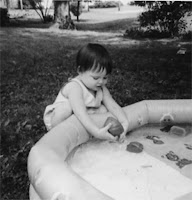Friday, July 29, 2022
Beach month ~ Let's go Fishing!
Wednesday, July 27, 2022
Be a Scientist ~ International Monarch Monitoring Blitz, July 29 - August 7
Monday, July 25, 2022
Where Does a Walk Around the Block Take You?
Carlsen asks questions: what happened to the front porch? It used to be the place where neighbors would pull up a rocking chair or milk crate and chit chat. He takes readers on tours through a power plant, a sewer, a trash museum, even the inner-workings of a post office. How does the mail get from there to here? He opens our eyes to appreciate the natural side of things as well… things like pigeons, squirrels – even roadkill.
This is the sort of book that makes you want to walk slow enough that you can inspect the weeds pushing between the cracks in the sidewalk. This is the sort of book that inspires you to head outside before the sun dries the dew so you can look at spiderwebs on the fence.
This is the sort of book that makes you wonder: if I walk around the block today, what will I find? And leads one to ask: does it matter how I walk around the block? If I go in a counter-clockwise direction, will I see things differently? What if I play hopscotch with the fallen walnuts and hickory nuts? Walk at a snail’s pace?
- Walk sideways, like a crab
- Walk with a child
- Skip part of the way
- Walk backward (when you’re in a safe place)
- Look at all the flowers on your route
- Listen to the birds
- Notice people working ~ what are they doing?
- Walk at first light
- Walk after dark
- Look at doorways
- Examine things growing in the sidewalk
- Stop and smell the _______.
Friday, July 22, 2022
Beach Month ~ Let's Go Otter Watching!
Wednesday, July 20, 2022
Explore Outdoors ~ Striped Things
I was weeding in the garden and discovered this sly cat hiding in the fennel. Well, not "hiding" - more like chowing down. Apparently swallowtails love fennel. And I love the colors!
This week look for stripy things around your yard and neighborhood. You might find stripes on a fly, or a beetle. Maybe even a different kind of caterpillar.
Monday, July 18, 2022
Desert Lichens Can't Deal with Increasing Heat
 |
| Biocrust at the Birds of Prey National Conservation Area, Idaho / public domain |
 |
Repeat photos of biocrusts from the same area in 2004, 2009, 2014, and 2019 / USGS photo by Rebecca Finger-Higgins |
- Over the past 50 years, weather data show that temperatures in that park have increased 0.27°C each decade (nearly half a degree F). In addition, recent summers have been particularly warm.
- Nitrogen-fixing lichens have declined significantly. In 1967 and in 1996, those lichens made up 19% of the biocrust (the percentage fluctuated slightly from year to year). Since then, the percentage of nitrogen-fixing lichen has shrunk to just 5%, with no sign of increasing again.
- Before 2003, lichens sometimes declined temporarily and bounced back. Recently, they have showed a steady decline.
Friday, July 15, 2022
Beach Month ~ Let's Check Out a Tide Pool!
 |
| from Rye Nature Center |
Wednesday, July 13, 2022
Explore Outdoors ~ Blackcaps
This is the best part of summer: blackcaps (raspberries) grow in neglected parts of our yard. Sure, they are full of seeds that get caught in your teeth, but they taste yummy as cereal and yogurt-toppers. Good on ice cream, too. And if you forget to eat breakfast before heading out to play, there's a snack growing nearby. The best part: birds love them, too! That's okay, because we've got way too many to keep to ourselves.
Monday, July 11, 2022
So, Your Kid Wants to be a Scientist or Engineer… Now What? by Jennifer Swanson
Friday, July 8, 2022
Beach Month ~ Let's go Beachcombing!
Wednesday, July 6, 2022
Explore Outdoors ~ Dainty Fungi
Friday, July 1, 2022
Fizz! Pop! Boom! Fourth of July Science
My kids loved to play with baking soda and vinegar. I’d find a bottle that fit a cork, then let them play around with those two ingredients to see how far up they could make their cork rocket fly. You can dress up a cork with some red and blue ribbons, but keep it light so it will fly.
Here are some other creative ways to celebrate the day:
Exploding sidewalk paint ~ use glow-in-the-dark paint for night fun
Flying chalk rockets ~ a different approach to sidewalk art
Fizzy sidewalk paint ~ perfect for toddlers
Fizzy pop chalk ~ for fingers or brushes
Erupting Rainbow ~ another fun one for the youngest kids
And how can we not include the Diet coke and mentos geyser ~ definitely outside fun!
Have a fizzy, fun weekend and I'll return on Wednesday for a nature break and more outside exploration.






.jpg)














